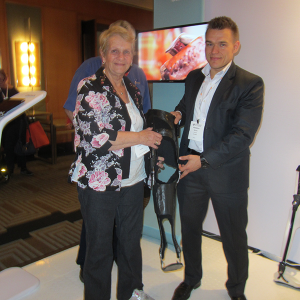 “Help me help myself”. This was one of the key messages to come from the 1st Australasia-Pacific Post-Polio Conference held in Sydney recently. In a keynote address, Dr Stephen de Graaff, rehabilitation physician and director of pain services at Epworth Health Australia, said communication within the rehabilitation sector to health providers like OTs, physiotherapists, GPs and nurses is critical to improving the health and wellbeing of polio survivors. He singled out the role of the OT which is the cornerstone of fatigue management.
“Help me help myself”. This was one of the key messages to come from the 1st Australasia-Pacific Post-Polio Conference held in Sydney recently. In a keynote address, Dr Stephen de Graaff, rehabilitation physician and director of pain services at Epworth Health Australia, said communication within the rehabilitation sector to health providers like OTs, physiotherapists, GPs and nurses is critical to improving the health and wellbeing of polio survivors. He singled out the role of the OT which is the cornerstone of fatigue management.
Pain associated with late effects of polio (LeoP) does affect quality of life. “You have to get in early, look at physical, psychological, social and even spiritual wellbeing and all these things need to be addressed. In order to manage pain it is necessary to think about positive and negative influences.
“When we do pain management it works most effectively within a rehab model. First, help the patient understand what is happening to them by working on their perceived level of pain and suffering. Sometimes we treat the stress and not the pain with medications but cautiously, as patients can get overmedicated. We put strategies in place to cope with disability and stress because ultimately we want the person to take responsibility. When we talk about pain management we talk about physical activities, massage, protecting joints, stabilising the back, knee support. Orthotics is important as is educating the OT or whoever is involved in their management,” he told F2L.
“As part of patient education we cover known causes of pain; why we are doing it and what the goals and options are and whether there is a role for medications. When it comes to the severity of pain, what makes it better or worse, how does it impact on sleep, do they require medication for it?”
According to de Graaff the challenge is that polio survivors usually present with disability over health issues but admitted management strategies can be challenging. “There is no cure for persistent and chronic pain we just try to manage it. Fatigue and pain like working together and not in a positive way.”
As for the NDIS the problem is that by the time the NDIS is rolled out 85 to 90 per cent of the polio population will be over the age of 65. “It is an issue that Polio Australia is lobbying the government about and asking why this cannot be addressed, which is a reasonable question to ask because 65 years is not old and seems to be a number that has just been plucked out.”
The polio communities in Victoria and New South Wales are particularly active in managing themselves and are very proactive, he said. The difficulty with other states like Western Australia, South Australia and Tasmania is that the population is not as dense and the numbers are not so great, so resources are scarce.
The key message is that while polio survivors have unique challenges a lot of these can be addressed. “Just because something cannot be cured does not mean it cannot be helped so we tend to manage rather than treat.”
He said it was important to identify the bio mechanical issues early to stop some of the physical deterioration before it occurs. “Also we would like to have medications for pain and fatigue management that patients can tolerate that give them energy without complications and assist with their quality of life which we don’t have at the moment.”
Vladislav Marek, business unit manager, Ottobock, demonstrating the E-Mag active orthotic brace
